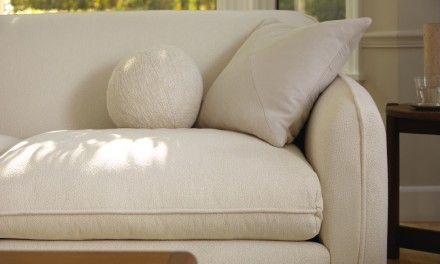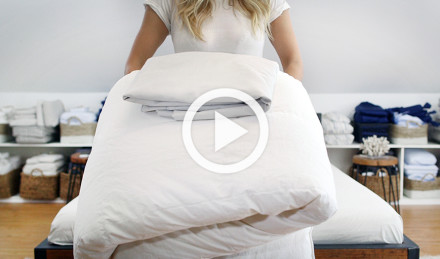The living room couch is one of the most well-loved parts of any home. From movie-watching and entertaining friends to curling up with a blanket and a good book, we spend plenty of time on our couches.
That extra use creates a lovely heart-center for your home, but it can also lead to accumulated pet hair, crumbs, dust, dirt and oils.
If you’re not sure how to clean a couch or how often to wash a couch, we’ll cover all the finer points below, so you can enjoy a tidy, healthy home all year long.
Keeping Your Couch Clean for a Healthier Home
When you have a busy schedule, it’s easy to ignore your couch during routine housework. Many of us only think to clean a sofa when it has a visible stain.
Yet cleaning or washing a couch isn’t just about keeping up appearances. This vital chore has important health implications, too. The fabrics in your home accumulate dust, allergens, germs and odors. A regular couch-cleaning schedule eliminates these invaders so you can breathe easier when you settle in.
How Often Should You Clean Your Couch?
You don’t need to wash your couch cushions or do a deep couch clean very often. Unless you’re particularly susceptible to allergens, you should only deep clean your couch once or twice a year. Between deep cleans, it's a good idea to perform quicker, surface cleanings every 3-4 weeks.
Common Reasons to Clean Your Sofa
Generally, you should clean your couch in addition to your normal cleaning schedule in a few key situations. Food and beverage spills, wintertime road salt residue, guests with allergies and viruses in the home are all common reasons to clean your couch in real time.
Keeping Your Couch Clean for a Healthier Home
When you have a busy schedule, it’s easy to ignore your couch during routine housework. Many of us only think to clean a sofa when it has a visible stain.
Yet cleaning or washing a couch isn’t just about keeping up appearances. This vital chore has important health implications, too. The fabrics in your home accumulate dust, allergens, germs and odors. A regular couch-cleaning schedule eliminates these invaders so you can breathe easier when you settle in.
How Often Should You Clean Your Couch?
You don’t need to wash your couch cushions or do a deep couch clean very often. Unless you’re particularly susceptible to allergens, you should only deep clean your couch once or twice a year. Between deep cleans, it's a good idea to perform quicker, surface cleanings every 3-4 weeks.
Common Reasons to Clean Your Sofa
Generally, you should clean your couch in addition to your normal cleaning schedule in a few key situations. Food and beverage spills, wintertime road salt residue, guests with allergies and viruses in the home are all common reasons to clean your couch in real time.
How to Clean a Couch From Start to Finish
Life would be easier if you could toss your whole couch in the washing machine. However, for most of us, washing a sofa is a multi-step process.
For some routine cleanings, you only need to follow one or two of the steps below. On other occasions, you may find yourself performing every step.
Some fabrics are more sensitive than others, so be sure to test cleaners and tools on an out-of-sight area first. Your furniture will have a label (usually underneath) that says how to wash a couch that’s made from its particular materials.
Remove Hair and Debris
A vacuum cleaner with an upholstery wand or nozzle is a big help for the first phase of dry couch cleaning.
Loosen any caked-on dirt with a bristle brush. Next, vacuum each cushion on all sides to remove loosened pet hair, dust, dirt and other accumulated debris. Make sure to vacuum underneath and between the cushions, too.
Most of the time, you only need to do a few minutes of vacuuming to be rewarded with a fresh, clean couch.
Clean Upholstery With Steam
Steam cleaning your couch is a popular way to deal with odors, stains, allergens and bacteria. Steaming works best on durable fabrics that won’t be damaged by getting wet.
For steam cleaning, you’ll need a carpet steam cleaner with a furniture attachment, a clothing steamer or an iron with a steam setting. If you don’t own a steamer, many grocery stores and hardware stores have them available for rent.
Perfect Steaming Technique
Steam your couch and cushions with quick strokes, moving the steamer constantly so you don’t oversaturate the cushions or upholstery. When done, give each cushion a chance to dry before putting it back on the couch.
Many steam machines will suck the moisture back out of the couch as they go along. If you use a clothing steamer or an iron, you’ll need to give your couch plenty of time to dry.
Be careful to avoid burning yourself with steam. Steam rises, so you should never stand directly over a steamer’s nozzle.
Disinfect Your Couch
Whether you’ve had a sick family member or you’re being proactive about preventing germs from hiding in your furniture, you may want to disinfect your couch.
Steam cleaning is the most common method of disinfecting furniture, but if you don’t have access to a steamer there are a couple of effective options you can try.
Some manufacturers of household cleaners sell home disinfectant sprays. However, it’s important to make sure the spray you choose is safe to use on fabrics. Test the cleaner on a hidden area to make sure the spray won’t damage your upholstery.
With store-bought disinfectant, make sure to follow the manufacturer’s instructions and provide plenty of ventilation. You can also save money by making your own couch disinfectant spray. Just use the recipe below.
How to Clean a Couch From Start to Finish
Life would be easier if you could toss your whole couch in the washing machine. However, for most of us, washing a sofa is a multi-step process.
For some routine cleanings, you only need to follow one or two of the steps below. On other occasions, you may find yourself performing every step.
Some fabrics are more sensitive than others, so be sure to test cleaners and tools on an out-of-sight area first. Your furniture will have a label (usually underneath) that says how to wash a couch that’s made from its particular materials.
Remove Hair and Debris
A vacuum cleaner with an upholstery wand or nozzle is a big help for the first phase of dry couch cleaning.
Loosen any caked-on dirt with a bristle brush. Next, vacuum each cushion on all sides to remove loosened pet hair, dust, dirt and other accumulated debris. Make sure to vacuum underneath and between the cushions, too.
Most of the time, you only need to do a few minutes of vacuuming to be rewarded with a fresh, clean couch.
Clean Upholstery With Steam
Steam cleaning your couch is a popular way to deal with odors, stains, allergens and bacteria. Steaming works best on durable fabrics that won’t be damaged by getting wet.
For steam cleaning, you’ll need a carpet steam cleaner with a furniture attachment, a clothing steamer or an iron with a steam setting. If you don’t own a steamer, many grocery stores and hardware stores have them available for rent.
Perfect Steaming Technique
Steam your couch and cushions with quick strokes, moving the steamer constantly so you don’t oversaturate the cushions or upholstery. When done, give each cushion a chance to dry before putting it back on the couch.
Many steam machines will suck the moisture back out of the couch as they go along. If you use a clothing steamer or an iron, you’ll need to give your couch plenty of time to dry.
Be careful to avoid burning yourself with steam. Steam rises, so you should never stand directly over a steamer’s nozzle.
Disinfect Your Couch
Whether you’ve had a sick family member or you’re being proactive about preventing germs from hiding in your furniture, you may want to disinfect your couch.
Steam cleaning is the most common method of disinfecting furniture, but if you don’t have access to a steamer there are a couple of effective options you can try.
Some manufacturers of household cleaners sell home disinfectant sprays. However, it’s important to make sure the spray you choose is safe to use on fabrics. Test the cleaner on a hidden area to make sure the spray won’t damage your upholstery.
With store-bought disinfectant, make sure to follow the manufacturer’s instructions and provide plenty of ventilation. You can also save money by making your own couch disinfectant spray. Just use the recipe below.
How to Make a DIY Couch Cleaner
Many of us have rubbing alcohol in our medicine cabinets. Just like you can disinfect a cut with rubbing alcohol, you can use it to kill germs and viruses on furniture. For a homemade disinfectant solution for washing couches, mix one cup of water with two cups of rubbing alcohol in a spray bottle.
Then, lightly mist your sofa’s surfaces and let them air dry.
How to Make a DIY Couch Cleaner
Many of us have rubbing alcohol in our medicine cabinets. Just like you can disinfect a cut with rubbing alcohol, you can use it to kill germs and viruses on furniture. For a homemade disinfectant solution for washing couches, mix one cup of water with two cups of rubbing alcohol in a spray bottle.
Then, lightly mist your sofa’s surfaces and let them air dry.
How to Wash an Upholstered Couch
Different types of fabric require different cleaners and methods of care depending on how delicate and porous they are. In some cases, you can machine wash a couch-cushion cover as long as it's removable. Use leather soap on leather couches, and a vinegar, water, and laundry soap mix on fabric.
How to Clean a Sofa Made of Leather
Leather and faux-leather couches are relatively easy to wash using leather cleaner, leather soap or diluted gentle hand soap. You can find leather soap and cleaning wipes in the automotive aisle of many stores. If stained, blot with a damp cloth as soon as possible.
Fabric Upholstery Cleaning
Store-bought fabric upholstery cleaner is a good choice to use on a sofa, but you can also make a solution of 2 tablespoons of white vinegar, 2 tablespoons of gentle laundry detergent and 2 cups of warm water. Use a rag or microfiber cleaning cloth to rub the cleaner into the upholstery. Then, air-dry.
How to Wash an Upholstered Couch
Different types of fabric require different cleaners and methods of care depending on how delicate and porous they are. In some cases, you can machine wash a couch-cushion cover as long as it's removable. Use leather soap on leather couches, and a vinegar, water, and laundry soap mix on fabric.
How to Clean a Sofa Made of Leather
Leather and faux-leather couches are relatively easy to wash using leather cleaner, leather soap or diluted gentle hand soap. You can find leather soap and cleaning wipes in the automotive aisle of many stores. If stained, blot with a damp cloth as soon as possible.
Fabric Upholstery Cleaning
Store-bought fabric upholstery cleaner is a good choice to use on a sofa, but you can also make a solution of 2 tablespoons of white vinegar, 2 tablespoons of gentle laundry detergent and 2 cups of warm water. Use a rag or microfiber cleaning cloth to rub the cleaner into the upholstery. Then, air-dry.
How to Wash a Couch That’s Stained or Soiled
If you’re dealing with serious stains like spilled red wine, puppy accidents or ink, we recommend blotting up as much of the stain as possible, then splash with carbonated water. Blot and repeat. If there is no improvement, dampen the stain with water, apply the detergent solution with a clean sponge, and blot again. Repeat until the stain has cleared. Dab again with water to remove the detergent.
How to Wash a Couch That’s Stained or Soiled
If you’re dealing with serious stains like spilled red wine, puppy accidents or ink, we recommend blotting up as much of the stain as possible, then splash with carbonated water. Blot and repeat. If there is no improvement, dampen the stain with water, apply the detergent solution with a clean sponge, and blot again. Repeat until the stain has cleared. Dab again with water to remove the detergent.
When to Replace Couches and Upholstery
Typically, a couch can last anywhere from five to fifteen years depending on the amount of use it gets and how well you maintain it. If you routinely clean and wash your couch, the upholstery can last throughout its life.
If the fabric on your couch is showing signs of thinning, permanent staining or tearing, reupholstering it with new fabric is an eco-friendly and economical way to get a few more years out of your well-loved sofa.
When to Replace Couches and Upholstery
Typically, a couch can last anywhere from five to fifteen years depending on the amount of use it gets and how well you maintain it. If you routinely clean and wash your couch, the upholstery can last throughout its life.
If the fabric on your couch is showing signs of thinning, permanent staining or tearing, reupholstering it with new fabric is an eco-friendly and economical way to get a few more years out of your well-loved sofa.
Select High-Quality Couches for Long-Lasting Use
When it’s time to replace your old couch, investing in a high-quality replacement can help ensure it lasts for years to come — no matter how much you use it. Browse the sofa collection by Parachute, and you’ll find plenty of comfortable, durable and stylish sofas to complement any home.
With your choice of easy-to-care-for fabrics like washed linen, linen cotton slub, eco-nubby texture, eco linen blend and eco basketweave upholstery in a range of neutral, soothing colors, you’ll spend less time worrying about your couch and more time lounging comfortably!
Select High-Quality Couches for Long-Lasting Use
When it’s time to replace your old couch, investing in a high-quality replacement can help ensure it lasts for years to come — no matter how much you use it. Browse the sofa collection by Parachute, and you’ll find plenty of comfortable, durable and stylish sofas to complement any home.
With your choice of easy-to-care-for fabrics like washed linen, linen cotton slub, eco-nubby texture, eco linen blend and eco basketweave upholstery in a range of neutral, soothing colors, you’ll spend less time worrying about your couch and more time lounging comfortably!







